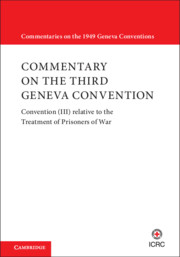 Commentary on the Third Geneva Convention
Commentary on the Third Geneva Convention Book contents
- Commentary on the Third Geneva Convention
- International Committee of the Red Cross
- Copyright page
- Contents
- Foreword by Peter Maurer
- Acknowledgements
- Abbreviations
- Introduction
- Preamble
- Part I General Provisions
- Part II General Protection of Prisoners of War
- Part III Captivity
- Part IV Termination of Captivity
- Part V Information Bureaux and Relief Societies for Prisoners of War
- Part VI Execution of the Convention
- Section I General provisions
- Article 126 Supervision by the Protecting Powers and the ICRC
- Article 127 Dissemination of the Convention
- Article 128 Translations. Implementing Laws and Regulations
- Article 129 Penal Sanctions
- Article 130 Grave Breaches
- Article 131 Responsibilities of the Contracting Parties
- Article 132 Enquiry Procedure
- Section II Final provisions
- Book part
- Sources
- Index
- References
Article 126 - Supervision by the Protecting Powers and the ICRC
from Section I - General provisions
Published online by Cambridge University Press: 21 August 2021
- Commentary on the Third Geneva Convention
- International Committee of the Red Cross
- Copyright page
- Contents
- Foreword by Peter Maurer
- Acknowledgements
- Abbreviations
- Introduction
- Preamble
- Part I General Provisions
- Part II General Protection of Prisoners of War
- Part III Captivity
- Part IV Termination of Captivity
- Part V Information Bureaux and Relief Societies for Prisoners of War
- Part VI Execution of the Convention
- Section I General provisions
- Article 126 Supervision by the Protecting Powers and the ICRC
- Article 127 Dissemination of the Convention
- Article 128 Translations. Implementing Laws and Regulations
- Article 129 Penal Sanctions
- Article 130 Grave Breaches
- Article 131 Responsibilities of the Contracting Parties
- Article 132 Enquiry Procedure
- Section II Final provisions
- Book part
- Sources
- Index
- References
Summary
Article 126 provides for an in situ (on site)supervision mechanism for scrutinizing compliance with the rights andobligations governing the protection of prisoners of war. Supervision may beundertaken by two actors: the Protecting Powers, where such are appointedaccording to Article 8 (or its substitutes appointed according to Article10), and the ICRC. This provision recognizes the supervisory role the ICRChad already been playing prior to 1949 on the basis of its right ofhumanitarian initiative. The ICRC’s right to access all persons detained inrelation to an international armed conflict is today recognized ascustomary.
- Type
- Chapter
- Information
- Commentary on the Third Geneva ConventionConvention (III) relative to the Treatment of Prisoners of War, pp. 1785 - 1807Publisher: Cambridge University PressPrint publication year: 2021
